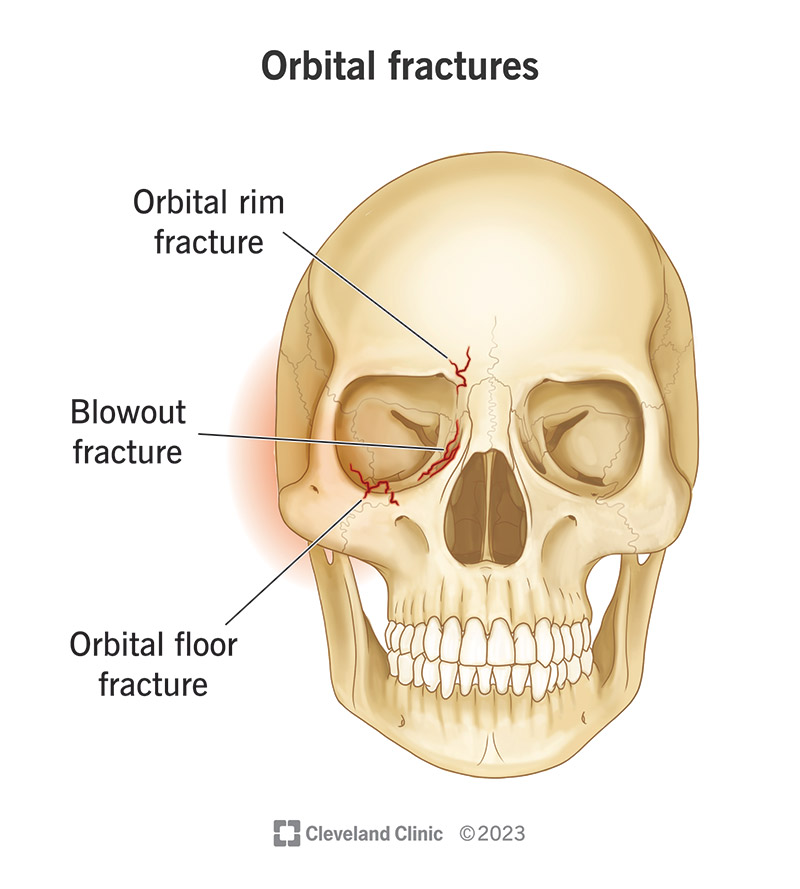An orbital fracture is when you break one or more of the bones that make up your eye socket. There are several different kinds of orbital fractures. The most common causes of orbital fractures are car accidents and getting hit in the face with a fist or ball. Treatment will vary depending on the type and severity of your injury.
Advertisement
Cleveland Clinic is a non-profit academic medical center. Advertising on our site helps support our mission. We do not endorse non-Cleveland Clinic products or services. Policy

An orbital fracture is when you break one or more of the bones surrounding your eyeball. These are your orbital bones, or the bones of your eye socket. This bony cavity contains your eyeball, eye muscles, blood vessels, nerves and other structures. Blunt force trauma — when something hits your eye very hard — is the most common cause of an orbital fracture.
Advertisement
Cleveland Clinic is a non-profit academic medical center. Advertising on our site helps support our mission. We do not endorse non-Cleveland Clinic products or services. Policy
You can fracture any of the bones surrounding your eyeball. A few types of orbital fractures include:
Some people with orbital fractures have no symptoms. But they’re usually painful. It depends on what type of fracture you have and how severe your injury is. Symptoms may include:
Advertisement
Orbital fractures can occur in adults and children. The most frequent causes in adults include assaults (violence) and car accidents. The most common causes in children include car accidents and being hit in the face with a ball. Other causes of orbital fractures include bike accidents, motorcycle accidents, falls and other sports injuries.
Orbital fracture complications may include:
To diagnose an orbital fracture, an eye doctor (ophthalmologist) will examine your eye and the area surrounding it. They’ll check to see if your eye moves normally and if you have any vision issues. They may measure your eye to make sure it’s positioned correctly in your eye socket.
The ophthalmologist will also ask you about your symptoms and request imaging tests, like X-rays and CT (computed tomography) scans.
Orbital fracture treatment depends on the type and severity of your eye injury. It doesn’t always require surgery. If you have a small fracture, an ophthalmologist may recommend using an ice pack to reduce eye pain and swelling. Your eye socket may heal on its own over time.
Your ophthalmologist may prescribe antibiotics or decongestants as well. They’ll instruct you to avoid blowing your nose while your injury heals. This can cause swelling if the air you blow out collects under the skin around your eye.
An orbital fracture is more severe when it prevents you from moving your eye correctly or if you also have double vision. If this is the case, your ophthalmologist may refer you to an oculoplastic surgeon. This type of surgeon is a specially trained ophthalmologist.
If you need surgery, the surgeon will let you know what type you need based on your symptoms and the severity of your injury.
After surgery, you may have bruising and swelling for several days. And your vision may be blurry for a few days following surgery. Your surgeon may recommend cold compresses, antibiotics or anti-inflammatory medication to help during the healing process.
Advertisement
The outlook for an orbital fracture depends on the type and severity of your injury. If you have a simple fracture, it may heal on its own over time. More severe fractures may require surgery. In the most severe cases, vision loss or double vision may occur. But most fractures heal without long-term effects.
Orbital fracture recovery time varies. Simple fractures may heal on their own over time. If your injury is severe and requires surgery, recovery may be prolonged. Some people develop nerve pain that can last for up to nine months. Other people may have persistent double vision, which could require another surgery. Enophthalmos, when your eyes sink in, may worsen with time.
After surgery for an orbital fracture, most people can return to school or work within a week. Although, you may need to limit any strenuous activity, airplane travel and deep-sea diving for several weeks after surgery.
You can’t always prevent orbital fractures, but there are certain things you can do to try to avoid them, including wearing:
If you have an orbital fracture, an ophthalmologist may recommend ice packs or cold compresses to help with pain and swelling. You’ll also want to keep your head elevated above your heart level to help prevent further swelling. Pain relievers can help with the pain. To prevent nosebleeds, your ophthalmologist may recommend using a nasal spray to constrict your blood vessels for two to three days.
Advertisement
If you’ve been treated for an optical fracture, return to your healthcare provider if you have:
You should go to your nearest emergency room or call 911 if you develop any of the following symptoms:
Questions you may want to ask your healthcare provider include:
It happens in a flash. A baseball comes flying at your eye. Or maybe you’ve sustained injuries in a car crash. Either way, you may have ended up with an orbital fracture. These types of fractures can cause pain, swelling and more severe symptoms like vision trouble. While an orbital fracture may go away on its own, it’s best to have it checked out by an ophthalmologist. They can determine if you need surgery or if ice and other at-home treatments are all you need to heal.
Advertisement
Facial injuries can change your life. At Cleveland Clinic, our providers are there to support you through every step of facial trauma reconstruction.

Last reviewed on 06/14/2023.
Learn more about the Health Library and our editorial process.